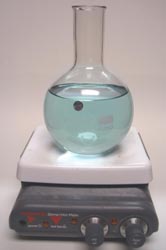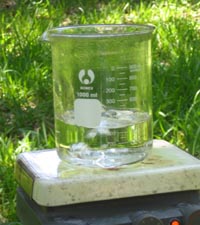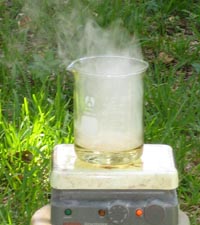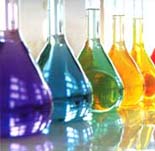Concentrating Sulfuric Acid (H2SO4)
Introduction

Sulfuric acid is an incredibly useful chemical and is readily available in the form of ‘Battery Acid’ used in Lead-Acid batteries (such as those found in automobiles). One can purchase Sulfuric / Battery acid at a very reasonable price at local automotive stores; this acid will usually have a concentration of about 30% to 35% H2SO4 by weight, the remainder being water.
For many applications, 30% H2SO4 will be more than concentrated enough to meet one’s needs, however on occasion one might require a substantially higher concentration of Sulfuric acid. But purchasing concentrated Sulfuric acid can be much more costly and a greater hassle than buying battery acid, so a process which would enable one to concentrate Sulfuric acid oneself can sometimes be a desirable alternative.
Fortunately, such a process exists and is relatively simple to perform.
One can concentrate Sulfuric acid by heating the liquid and boiling off water from the solution, leaving concentrated H2SO4 behind. By following this procedure, Sulfuric acid solutions may be concentrated to upwards of 98% H2SO4 by weight.
Safety 
Safety is of paramount importance when concentrating Sulfuric Acid.
The concentrating process involves boiling Sulfuric acid to drive the water out of the solution. One should always handle Sulfuric acid with great care, but this is especially true when dealing with hot, concentrated, Sulfuric acid since it has the ability to act as an oxidizing acid. Needless to say, boiling Sulfuric acid is not something one would want to come into contact with due to the extremely corrosive nature of the acid, not to mention the injury incurred by a liquid boiling at several hundred degrees Celsius.
One absolutely must wear proper protective clothing.
 Water (steam) is not the only vapor given off by the boiling acid. Along with water, Sulfur Dioxide and Trioxide (SO2 and SO3) gasses also evolve from the boiling liquid. At low acid concentrations, water is the predominant vapor given off by the boiling acid; significantly more water vapor evolves from the boiling liquid than SOx gasses, thus allowing one to concentrate the acid through boiling. As the concentration rises, so does the amount of SOx gasses given off by the acid. At higher concentrations the boiling acid begins to release, thick, toxic, SOx fumes. For this reason, one must perform the boiling outside in an area with plenty of ventilation and one should maintain a significant distance from the acid to avoid breathing in the harmful fumes.
Water (steam) is not the only vapor given off by the boiling acid. Along with water, Sulfur Dioxide and Trioxide (SO2 and SO3) gasses also evolve from the boiling liquid. At low acid concentrations, water is the predominant vapor given off by the boiling acid; significantly more water vapor evolves from the boiling liquid than SOx gasses, thus allowing one to concentrate the acid through boiling. As the concentration rises, so does the amount of SOx gasses given off by the acid. At higher concentrations the boiling acid begins to release, thick, toxic, SOx fumes. For this reason, one must perform the boiling outside in an area with plenty of ventilation and one should maintain a significant distance from the acid to avoid breathing in the harmful fumes.
One should only use undamaged, heat-resistant, borosilicate glass containers to boil the acid, such as Pyrex® (or, alternatively, Bomex) brand laboratory glassware. Do not use metal, plastic, or ordinary glass containers as they will not be able to withstand the corrosive nature of the acid or the high temperatures experienced during the boiling process.
A laboratory hot plate is the preferred heat source to boil the acid; an open-flame heat source is strongly discouraged as it places unnecessary stress on the glassware and may cause it to crack.
One would be wise to be prepared for the unfortunate (and hopefully unlikely) event of an accident occurring during the concentrating process, even after taking all the proper precautions. In case of a spill, having a bucket of water and an ample supply of Sodium Bicarbonate (baking soda) handy would be a very good idea in order to dilute and neutralize the acid.

Due to its highly corrosive nature and potential oxidizing properties, Sulfuric acid can be extremely dangerous when not handled responsibly. Always wear proper protective clothing when working around Sulfuric Acid (including, but not limited to, gloves and eye protection), and practice appropriate safety precautions.
 |
Pre-Boiling
Pour the dilute acid to be concentrated into an appropriate boiling container (Pyrex® labware or equivalent) and begin to heat the liquid by gradually increasing the temperature setting on the heating apparatus.
Optionally, one may add boiling stones or other chemically inert objects to the container in order to better facilitate a controlled boiling process. The rough edges of the boiling stones assist in the formation of gas bubbles as molecules make the transition into the vapor phase as the liquid begins to boil. Without this, it is possible for the liquid to become ‘super-heated’ as the liquid’s temperature rises beyond its boiling point. The super-heated state can be easily disturbed and the liquid can suddenly begin to boil vigorously and can potentially boil over or splatter out of the container.
Boiling
When the acid begins to boil, water (steam) will be the most predominant vapor evolved from the solution. As the water leaves, the Sulfuric acid is left behind in a smaller and more concentrated solution.
As the acid becomes more concentrated, its boiling point will rise. Pure Sulfuric acid will boil at a temperature of 337 ºC (610 K, 639 ºF), whereas the more dilute the solution is, the closer its boiling point will be to that of water (100 ºC).
 |
 |
 |
Fuming
After a substantial portion of the water has boiled away, thick, white, fumes of SOx gasses will begin to evolve from the boiling acid.
Depending on the initial concentration and volume of the dilute acid, it may require several hours of boiling in order to reach this stage.
The significantly increased concentration of the SOx gasses in the fumes will be easy to differentiate from the ordinary water vapor evolving during the previous stage of the process. Compare the images of the boiling acid (above) to those of the fuming acid (below); the fumes from the “Boiling” stage are practically invisible whereas the fumes from the “Fuming” stage are thick and easily detectable.
The fumes containing the SOx gasses will grow thicker as the concentration of the acid increases allowing one to use them as a crude method gauging the concentration of the acid.
 |
 |
Done
When the boiling acid’s volume falls to about 20% - 25% of its original volume, one may stop boiling the acid and begin to let the liquid cool back down.
Once the acid cools, carefully pour it into an appropriate storage container. Do not leave the cooled acid uncovered too long as Sulfuric acid is hygroscopic and will slowly absorb moisture from the air and dilute itself.
At this point, one should have obtained a Sulfuric acid solution which has a concentration somewhere around 95% H2SO4. One can obtain a theoretical maximum concentration of 98.3% H2SO4 by weight, but past this point the Sulfuric acid boils off with the water at a rate which does not allow the solution to become more concentrated.
If one wished to know more precisely the concentration of the recently prepared acid, one can measure the density of the Sulfuric acid and compare this measured value with that found in a chart containing the known H2SO4 concentration for a specified density. Additionally, one can perform a titration with an alkaline (basic) solution of a known concentration to calculate the H2SO4 concentration.
H2SO4 Density Table [from CRC Handbook of Chemistry and Physics, 81st edition, p. 8-81], showing molality (m, moles / kg), Molarity (c, mol / L), density (ρ, g / cm3) for a given mass percent of Sulfuric acid solution.
 |
 |
Last updated:
05/13/2007


